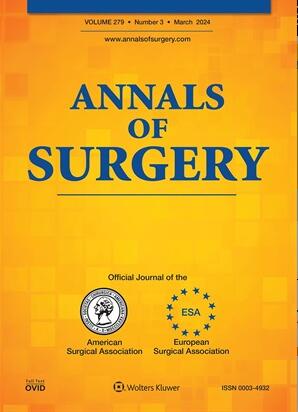A Prospective European Trial Comparing Laparotomy, Laparoscopy, Robotic-Assisted, and Transanal Total Mesorectal Excision Procedures in High-Risk Patients with Rectal Cancer: The RESET Trial.
IF 7.5
1区 医学
Q1 SURGERY
引用次数: 0
Abstract
OBJECTIVE To compare total mesorectal excision (TME) techniques combined with sphincter-sparing procedure in high-risk patients (HRPs). BACKGROUND TME is the standard treatment for rectal cancer, but can be challenging in HRPs. The available surgical approaches must be compared, especially in HRPs. METHODS Prospective, observational, multicenter trial to compare laparotomy (OTME), laparoscopy (LTME), robotic-assisted surgery (RTME), and transanal surgery (TaTME) in HRPs. The composite primary outcome included circumferential radial margin (CRM) ≥1mm, TME grade II-III, and absence of Clavien-Dindo grade III-IV complications. Three propensity score analyses were performed (LTME vs. RTME, RTME vs. TaTME, LTME vs. TaTME). RESULTS 1078 HRPs (75% of men, median body mass index of 27 kg/m2, 50% of tumors in the lower third of the rectum) underwent surgery. The RTME and TaTME groups included patients with more advanced and lower tumors and coloanal anastomosis (P<0.001). Operative time was longer for RTME surgery (P<0.001). Conversion rate was similar for minimally invasive procedures (4.5%). The global R0 resection rate was 96% without difference among techniques. The primary outcome rates were 82.4%, 64.3%, 74.7%, and 80.3% for LTME, OTME, RTME, and TaTME, respectively. None achieved the expected success rate (85%), and propensity score analyses found no differences. Operative results were similar between high- and low-volume inclusion centers only for RTME. CONCLUSIONS The RESET trial yielded high-quality results despite focusing on HRPs. Minimally invasive procedures showed similar sphincter-sparing procedure outcomes, but LTME included patients with more favorable tumors. Oncologic and functional outcomes will be evaluated at 2 years (ClinicalTrials.gov, ID: NCT03574493).一项前瞻性欧洲试验,比较直肠癌高风险患者的腹腔镜手术、腹腔镜手术、机器人辅助手术和经肛门全直肠系膜切除术:RESET 试验。
目的比较高危患者(HRPs)的全直肠系膜切除术(TME)技术与括约肌保留术。方法对高危直肠癌患者进行开腹手术(OTME)、腹腔镜手术(LTME)、机器人辅助手术(RTME)和经肛门手术(TaTME)的前瞻性、观察性、多中心试验。复合主要结果包括径向周缘(CRM)≥1毫米、TME II-III级、无Clavien-Dindo III-IV级并发症。结果1078名HRP(75%为男性,中位体重指数为27 kg/m2,50%的肿瘤位于直肠下1/3)接受了手术。RTME组和TaTME组包括肿瘤更晚期、位置更低和结肠吻合的患者(P<0.001)。RTME手术的手术时间更长(P<0.001)。微创手术的转归率相似(4.5%)。总体R0切除率为96%,不同技术间无差异。LTME、OTME、RTME和TaTME的主要结果率分别为82.4%、64.3%、74.7%和80.3%。没有一项达到预期的成功率(85%),倾向得分分析也未发现差异。结论:尽管 RESET 试验的重点是 HRP,但它还是取得了高质量的结果。微创手术显示出相似的括约肌保留手术结果,但LTME纳入的患者肿瘤情况更佳。肿瘤学和功能结果将在2年后进行评估(ClinicalTrials.gov,ID:NCT03574493)。
本文章由计算机程序翻译,如有差异,请以英文原文为准。
求助全文
约1分钟内获得全文
求助全文
来源期刊

Annals of surgery
医学-外科
CiteScore
14.40
自引率
4.40%
发文量
687
审稿时长
4 months
期刊介绍:
The Annals of Surgery is a renowned surgery journal, recognized globally for its extensive scholarly references. It serves as a valuable resource for the international medical community by disseminating knowledge regarding important developments in surgical science and practice. Surgeons regularly turn to the Annals of Surgery to stay updated on innovative practices and techniques. The journal also offers special editorial features such as "Advances in Surgical Technique," offering timely coverage of ongoing clinical issues. Additionally, the journal publishes monthly review articles that address the latest concerns in surgical practice.
 求助内容:
求助内容: 应助结果提醒方式:
应助结果提醒方式:


